Introduction
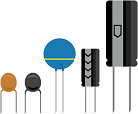
Capacitor
is a 2-terminal passive electronic component that stores energy in form of
electric charge

similar to a storage battery.
A capacitor is a pair of
two conductors separated
by a non-conductive region. The
non-conductive region can either be a vacuum or an electrically insulating material (known
as a dielectric), like glass,
air, paper, plastic, ceramic. [Remember a burger sandwich with layer of
vegetables or meat or cheese docked between bread slices?] Due to this insulating layer, DC current cannot
flow through the capacitor, and voltage is present across the plates in the
form of an electrical charge. Every
capacitor has Voltage as one of the rating parameters.
Working Principle
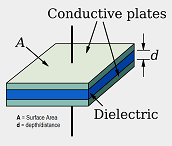
When there is a potential difference across
the conductors (e.g., when a capacitor is attached across a battery),
an electric field develops across the dielectric, causing positive
charge to collect on one plate and negative charge to collect on the other
plate. If a battery has been attached to a capacitor for a sufficient amount of
time, no current can flow through the capacitor. However, if an accelerating or
alternating voltage is applied across the leads of the capacitor,
a displacement current can flow.
Early capacitors were also known
as condensers, a term that is still occasionally used today.
The term was first used for this purpose by Alessandro Volta in 1782,
with reference to the device"s ability to store a higher density of electric
charge than a normal isolated conductor.
Capacitors in Series & in Parallel
connection
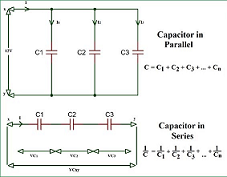
When capacitors are placed in parallel with one another the
total capacitance is simply the sum of all capacitances. This is analogous to the
way resistors add when in series. Much
like resistors are a pain to add in parallel, capacitors get funky when placed
in series. The total capacitance of all capacitors in series
is the inverse of the sum of all inverse capacitances.
Capacitor
rating

The effect of a
capacitor is known as ‘capacitance’. Like Ohm
as a resistance measurement unit of Resistors, Farad is the unit to measure value of a capacitor and is a
second parameter of capacitor rating.
This actually indicates how much energy a capacitor can store and termed
as its ‘capacitance’. Value of
capacitance varies between picofarad to kilofarad, and following table will
explain more of the range:
|
Value Name
|
Short Name
|
Weight
|
Value in
Farads
|
|
Picofarad
|
pF
|
10-12
|
0.000000000001 F
|
|
Nanofarad
|
nF
|
10-9
|
0.000000001 F
|
|
Microfarad
|
µF
|
10-6
|
0.000001 F
|
|
Milifarad
|
mF
|
10-3
|
0.001 F
|
|
Kilofarad
|
kF
|
103
|
1000 F
|
There is hardly any electronic circuit
which does not contain a capacitor in it. There are many different kinds of capacitors available from
very small capacitor beads used in resonance circuits to large power factor
correction capacitors, but they all do the same thing, they store charge.
Apart from storing electric charge, capacitors also can function to suppress
spikes and filter signals.
Performance factors
While deciding about a
suitable capacitor for any application, following
factors need to be considered:
- Size - Size both in terms of physical volume
and capacitance. It"s not uncommon for a capacitor to be the largest
component in a circuit. They can also be very tiny. More capacitance
typically requires a larger capacitor.
- Maximum voltage -
Each capacitor is rated for a maximum voltage that can be dropped across
it. Some capacitors might be rated for 1.5V, others might be rated for
100V. Exceeding the maximum voltage will usually result in destroying the
capacitor.
- Leakage current -
Capacitors aren"t perfect. Every cap is prone to leaking some tiny amount
of current through the dielectric, from one terminal to the other. This
tiny current loss (usually nanoamps or less) is called leakage. Leakage
causes energy stored in the capacitor to slowly, but surely drain away.
- Equivalent series resistance (ESR) -
The terminals of a capacitor aren"t 100% conductive, they"ll always have a
tiny amount of resistance (usually less than 0.01O) to them. This
resistance becomes a problem when a lot of current runs through the cap,
producing heat and power loss.
- Tolerance - Capacitors also can"t be made to have
an exact, precise capacitance. Each cap will be rated for their nominal
capacitance, but, depending on the type, the exact value might vary
anywhere from ±1% to ±20% of the desired value.
-
Capacitor
types
Capacitors are available in variety of types and they are
classified by various parameters as below:
by Material
Capacitors
are made in a many of shapes and sizes, all of which determine how well they
can hold a charge. The most common type of capacitors are:
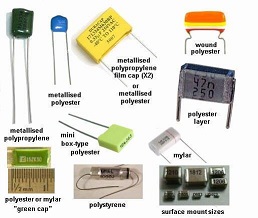
Ceramic Capacitors
Electrolytic
Capacitors
Tantalum Capacitors
Aluminium
Capacitors
Paper Capacitors
Mica Capacitors
Ceramic Capacitors
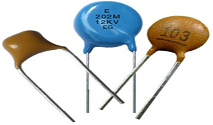
These are the most commonly seen capacitors even for simple
electronic projects. Unlike their electrolytic counterparts, ceramic
capacitors hold a smaller charge but also leak less current. They
also are usually the cheapest of capacitors.
Electrolytic Capacitors
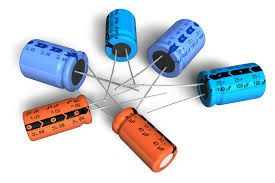
These look like small tin cans that we find on a
circuit board and can hold a massive electric charge in their tiny footprint.
They’re also the only type of capacitor that is polarized, meaning that they
will only work when wired in a particular orientation. On these electrolytic
capacitors, there’s a positive pin, called the anode, and a negative pin called
the cathode.
Despite being able to hold a large amount of
an electric charge, electrolytic caps are also well known for leaking current
quicker than ceramic caps. Hence, they’re not the best choice when we need to
store energy.
Tantalum Capacitors
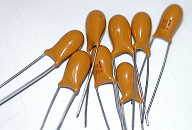
Tantalum capacitors are electrolytic capacitors which use
tantalum metal for the anode. They are polarized capacitors with superior
frequency and stability characteristics.
Tantalum capacitors are made with capacitance values ranging from 1nF
all the way to 72mF and they are much smaller in size than aluminium
electrolytic capacitors of the same capacitance.
Ceramic
capacitors typically specify insulation resistance, whereas tantalum
capacitors are graded by direct current leakage (or DCL).
Aluminium
Capacitors
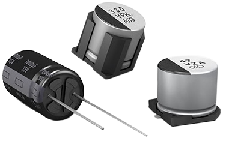
Aluminium capacitors are polarized electrolytic
capacitors.
Aluminium
electrolytic capacitors are found in many
applications such as power
supplies and computer motherboards. These
capacitors are used when
a large capacitance is required and leakage
current is not an important
factor. These capacitors are available in various
sizes and shapes
Paper Capacitors
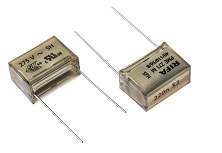
Paper capacitors are the fixed
capacitors that store a fixed amount of electric charge with a fixed
capacitance value. Paper capacitor is
also known as a Fixed capacitor, in which
paper is used as a dielectric medium, that stores energy in the form of the
electrical field. These capacitors are used at power line
frequency with a capacitance value of 1nF to 1uF. It stores a fixed amount of
electric charge.
Mica Capacitors
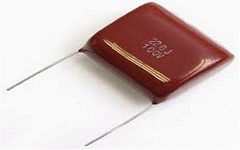
Mica is a silicate mineral found in
granites and other rocks. It is frequently used as an electrical insulator in
electrical applications. In mica capacitors, mica is used as
dielectric material. This dielectric material opposes the flow of electric
current or electric charges. Mica
capacitors are generally used when the design calls for
stable, reliable capacitors of relatively small values. They are
low-loss capacitors,
which allow them to be used at high frequencies, and their value does not
change much over time. Mica minerals are very stable electrically,
chemically and mechanically.
Supercapacitors
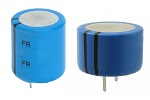
Supercapacitors are the superheroes of the capacitor family, and can store
a high amount of energy! Unfortunately, supercapacitors don’t handle excess
voltages very well and care needs to be taken to ensure proper voltage in the
circuit.
A supercapacitor, also called an ultracapacitor, is a
high-capacity capacitor with a capacitance value much higher than other
capacitors, but with lower voltage limits, that bridges the gap between
electrolytic capacitors and rechargeable batteries.
Unlike electrolytic capacitors, supercapacitors being used to store and
discharge energy, much like a battery. But in contrast to a battery, supercapacitors
release their charge all at once!
by Construction
Capacitor types are also made based on
their construction/structure, and most common types are:
Axial
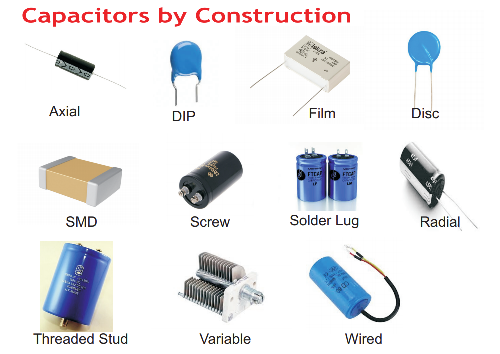
DIP
Disc
film
Radial
SMD
Screw
Solder lug
Stud threaded
variable
Wire
by function
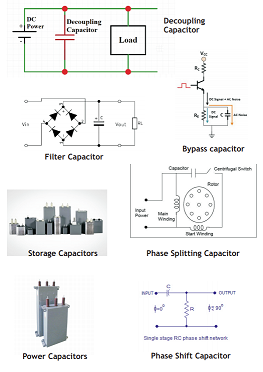
Decoupling capacitors (to decouple one
part of an electrical network (circuit) from another – for shunting noise)
Bypass capacitors (To short AC signals to the ground so as to remove any AC noise
present on a DC signal producing a much cleaner and pure DC signal)
Filter capacitors (To filter out certain unwanted frequency or series of
frequencies from an electronic circuit – Low Pass [to allow AC and block DC)
and High Pass filters (allow high frequency and block low frequency signals)]
Storage capacitors (to store extremely high energy in limited space
without sacrificing reliability, quality and degree of accuracy of
on-board supply)
Power Capacitors (They provide a static source of reactive power in electrical
distribution systems in applications like Power Factor correction, motor
starters, power supplies)
Phase-splitting capacitors (This capacitor connected in series with the starting winding
creates a phase shift of approximately 80 degrees between the starting and
running winding. This results in a higher starting torque, with less starting
current).
Phase shifting capacitors (In AC circuits voltage and current are changing continuously,
and in a purely capacitive AC circuit the peak value of the voltage waveform
occurs a quarter of a cycle after the peak value of the current. Therefore, a phase
shift is occurring in the capacitor, the amount of phase shift between voltage
and current is +90° for a purely capacitive circuit, with current LEADING the
voltage). In Electronics circuits (like phase shift oscillators), capacitors
are used to achieve phase shift to get desired results.
Credits:
Wikipedia, Electronics Tutorials, Sparkfun, Autodesk, Mouser, Iskra, ICAR, EPCOS,
Kemet, Vishay & other manufacturers (whose images are used)
This is a
brief overview of this topic. The
subject itself is vary vast and it’s not expected to cover every aspect
here. Technical details in this article
are compiled from best known sources.
These are of course open for any corrections and additions.